AMD A10-5800K & A8-5600K Review: Trinity on the Desktop, Part 2
by Anand Lal Shimpi on October 2, 2012 1:45 AM ESTContent Creation Performance
Adobe Photoshop CS4
To measure performance under Photoshop CS4 we turn to the Retouch Artists’ Speed Test. The test does basic photo editing; there are a couple of color space conversions, many layer creations, color curve adjustment, image and canvas size adjustment, unsharp mask, and finally a gaussian blur performed on the entire image.
The whole process is timed and thanks to the use of Intel's X25-M SSD as our test bed hard drive, performance is far more predictable than back when we used to test on mechanical disks.
Time is reported in seconds and the lower numbers mean better performance. The test is multithreaded and can hit all four cores in a quad-core machine.
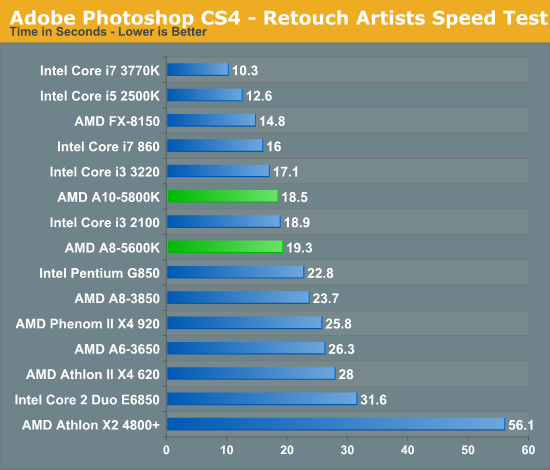
Our Photoshop workload still runs better on Intel hardware, but the gap in performance between the 5800K and 3220 is smaller than it was between the FX-8150 and 2500K last year. While Bulldozer was pretty much unrecommendable, Trinity approaches tradeoff territory.
3dsmax 9 & POV-ray
Today's desktop processors are more than fast enough to do professional level 3D rendering at home. To look at performance under 3dsmax we ran the SPECapc 3dsmax 8 benchmark (only the CPU rendering tests) under 3dsmax 9 SP1. The results reported are the rendering composite scores.
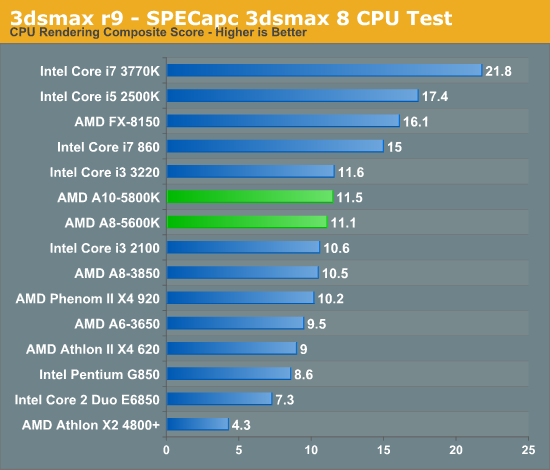
Once again in a heavily threaded FP benchmark, the A10 and Core i3 perform very similarly. POV-Ray is another example of this below:
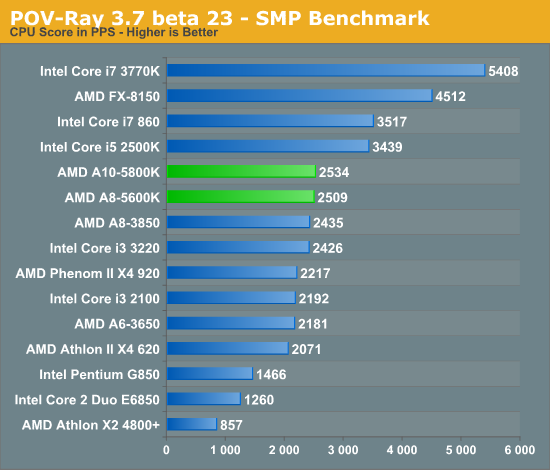
File Compression/Decompression Performance
Par2 is an application used for reconstructing downloaded archives. It can generate parity data from a given archive and later use it to recover the archive
Chuchusoft took the source code of par2cmdline 0.4 and parallelized it using Intel’s Threading Building Blocks 2.1. The result is a version of par2cmdline that can spawn multiple threads to repair par2 archives. For this test we took a 708MB archive, corrupted nearly 60MB of it, and used the multithreaded par2cmdline to recover it. The scores reported are the repair and recover time in seconds.
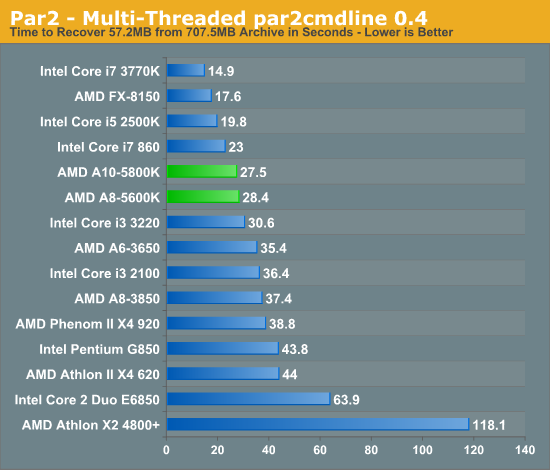
Our multithreaded Par2 recovery test shows AMD with a small advantage over the Core i3 3220, although it obviously can't touch any of the more expensive quad-core parts.
Excel Math Performance
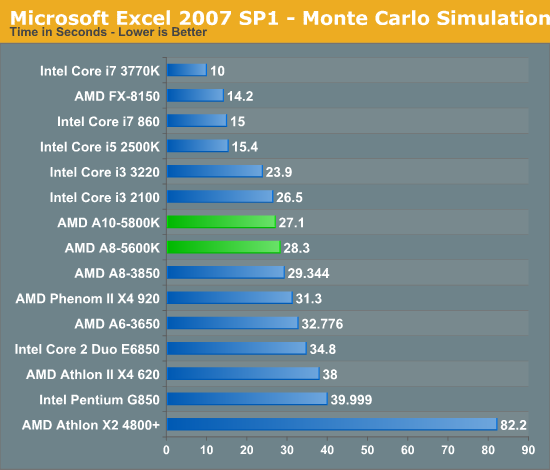
Not all heavily threaded FP applications are easy wins for AMD. In our Monte Carlo simulation benchmark the 3220 manages a decent lead over the A10-5800K.
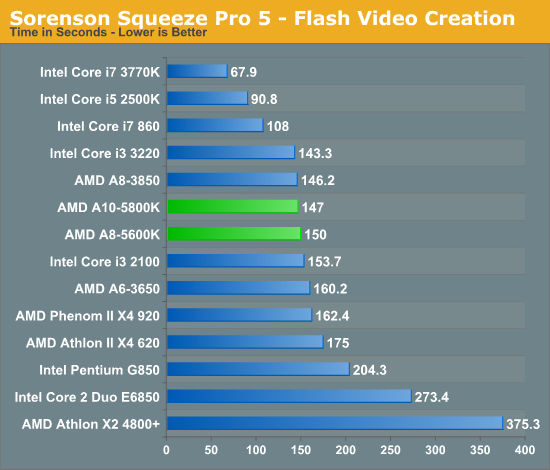
Our old Sorenson Squeeze test is one area where we see a slight regression compared to Llano. Like I mentioned earlier, this isn't super common but it does happen from time to time given the dramatic architecture difference between Llano and Trinity.










178 Comments
View All Comments
creed3020 - Tuesday, October 2, 2012 - link
I would really appreciate it if a similar test of Trinity as what was done to Llano regarding GPU Performance vs. Memory Speed was completed (http://www.anandtech.com/show/4476/amd-a83850-revi... I am curious if the trend has remained the same, improved, or decreased.I am in the process of building a new Office PC for family whose needs are basic and Trinity fits the bill quite well, especially the A8-5500 or A6-5400K. I want to purchase memory that compliments the GPU well.
On another GPU note I find it strange that there was no test of AMD Radeon Dual Graphics (http://www.amd.com/us/products/technologies/dual-g... as that a native scaling of GPU platform for this APU, not a high end discrete GPU. The latter usage scenario just doesn't seem that common considering the target market for the APU.
Hubb1e - Tuesday, October 2, 2012 - link
Go with 1866 or 1600. 1866 is about 5% faster GPU performance if that matter much in your use case.creed3020 - Wednesday, October 3, 2012 - link
My current HTPC uses an A8-3850 with 1866 memory so I am aware of the benefits, my question is more about getting an understanding of this phenomenon with Trinity. I am curious if it was has become less important or perhaps even more so.I'm not gaming on my APU so there is no concern to squeeze every drop of FPS out of the GPU. I am more curious from a research and review standpoint.
Moizy - Tuesday, October 2, 2012 - link
Anand, you mentioned several times that Trinity holds the integrated graphics and overclockadvantage, while Intel holds the single-threaded and power consumption advantage. To me, though, the A10-5700 attempts to address the power consumption advantage by offering a lower tdp without cutting down the clocks too much (while sacrificing overclockability though).
Throwing in the A10-5700 at some point in the future, assuming you can get your hands on one, would provide an interesting comparison for those interested in Trinity's gpu and competitive power consumption.
ewilliams28 - Tuesday, October 2, 2012 - link
apologies if it's been covered but i would like to know exactly which cards work in this mode. I have heard that if you go too high they don't work together. it's my understanding that 7670 are OEM only and i can't believe that the 6670 that i can buy is still the best i can do. i plan to use 1080p since 1920x1200 has basically gone the way of the dodo bird. but i do like to crank up the settings. luckily the most complicated game i play is World of Warcraft. i will probably fold with this box though.creed3020 - Tuesday, October 2, 2012 - link
http://www.amd.com/us/products/technologies/dual-g...halbhh2 - Tuesday, October 2, 2012 - link
Overall, a Trinity laptop would do fine during idle, which *is about 85%* of what 90% of laptops do when they are on.That matters.
So, an interesting test for real-world use for *most* consumers (wife, kids, most of the people most of us know) would be a run-time battery life test for leaving the computer on, and surfing to 25 web pages, and playing a couple of modest games for 45 minutes, and then watching a streamed movie.
That would be real world use for 90% of laptops.
In view of that, for people that aren't using their laptop in a demanding way, a good question is how much does it cost, and how long does it run until you need to plug in. That's all.
jfelano - Tuesday, October 2, 2012 - link
Why does Anandtech still use 1280x1024 and 1680x1050 as their bencmarks? Is this still 2008?Beenthere - Tuesday, October 2, 2012 - link
Answer: Because most people still use these screen resolutions. This review is for a desktop APU, thus the appropriate screen resolutions.silverblue - Tuesday, October 2, 2012 - link
Hehe... you try playing anything remotely recent at a higher resolution on an IGP...